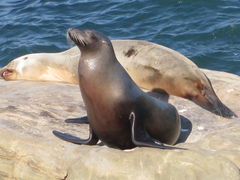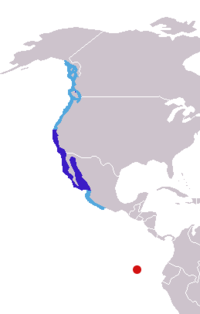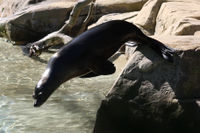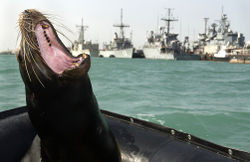California Sea Lion
| California Sea Lion | |
|---|---|
 |
|
| Male (Bull) | |
 |
|
| Female (Cow) | |
| Conservation status | |
| Scientific classification | |
| Kingdom: | Animalia |
| Phylum: | Chordata |
| Class: | Mammalia |
| Order: | Carnivora |
| Suborder: | Pinnipedia |
| Family: | Otariidae |
| Subfamily: | Otariinae |
| Genus: | Zalophus Gill, 1866 |
| Species: | Z. californianus |
| Binomial name | |
| Zalophus californianus (Lesson, 1828) |
|
 |
|
| California Sea Lion range | |
The California Sea Lion (Zalophus californianus) is a coastal sea lion of western North America. Their numbers are abundant (188,000 U.S. stock 1995 est.[2]), and the population continues to expand at a rate of approximately 5.0% annually.[3] They are quite intelligent, can adapt to man-made environments, and even adult males can be easily trained. Because of this, California sea lions are commonly found in public display in zoos and marine parks, used for entertainment in circuses, and trained by the US Navy for certain military operations. This is the classic circus "seal", despite that it is not a true seal.[4]
Contents |
Description
California sea lions grow to 300 kg (660 lb) and 2.4 meters (8 ft) long, while females are significantly smaller, at 90 kg (210 lb) and 2 meters (6.5 ft) long. They have pointed muzzles, making them rather dog-like. Males grow a large crest of bone on the top of their heads as they reach sexual maturity, and it is this that gives the animal its generic name (loph is "forehead" and za- is an emphatic; Zalophus californianus means "Californian big-head"). They also have manes, although they are not as well developed as the manes of adult male South American or Steller sea lions. Females are lighter in color than the males and pups are born dark, but lighten when they are several months old. When it is dry, the skin is a purple color. A sea lion's average lifespan is 17 years in the wild, and longer in captivity. By sealing their nose shut, they are able to stay underwater for up to 15 minutes.[5]
Vocalizations
California sea lions are well known for their dog-like barks.They are very vocal particularly during the breeding season. Adult males have deep loud barks made repeatedly when establishing territories. After that the males are mostly quiet unless its territorial boundaries have been violated by a rival. Barking may also attract mates. Female sea lions emit a unique vocalization when calling their pups and the pups themselves will bleat and make a high pitched alarm call. Juveniles and subadults of both sexes will make high pitched barks when alarmed.
Range and habitat
As its name suggests, the California sea lion is found mainly around the waters of California. However they can also be found from the Alaska Panhandle in the north to Mexico in the south. The Galápagos Sea Lion and the extinct Japanese Sea Lion were once considered subspecies of the Californian sea lion. Now these two populations are generally considered as distinct species.[6] California sea lions breed from the Channel Islands off southern California to Mexico and in the Gulf of California. Major breeding sites are San Miguel and the San Nicolas islands. However it appears that the sea lions have taken up breeding sites in northern California and females are now commonly found there.[1]
California sea lions prefer to breed on sandy beaches. They usually stay no more than 10 miles out to sea.[7] On warm days they stay close to the water's edge. At night or on cool days, the sea lions will move inland or up coastal slopes. Outside of the breeding season they will often gather at marinas and wharves and may even be seen on navigational buoys. These man-made environments provide safety from their natural predators; orcas and white sharks.
California sea lions can also live in fresh water for periods of time. They feast on Pacific salmon in front of Bonneville Dam, 146.1 river miles from the Pacific Ocean. Historically, sea lions hunted salmon in the Columbia River as far as The Dalles and Celilo Falls, 200 miles (320 km) from the sea, as remarked upon by people such as George Simpson in 1841. In 2004, a healthy sea lion was found sitting on a road in Merced County, California, almost a hundred miles upstream from San Francisco Bay and half a mile from the San Joaquin River[8].
Behavior
Diet

California sea lions feed on a wide variety of seafood, mainly squid and fish; sometimes even clams. Commonly eaten fish and squid species include salmon, hake, Pacific whiting, anchovies, herring, schooling fish, rock fish, lamprey, dog fish, and market squid.[9] They feed mostly around the edge of the continental shelf as well as sea mounts, the open ocean and the ocean bottom. Average annual food consumption of males in zoos increases with age to stabilize at approximately 4,000 kg (8,818 lbs)/year by the age of 10 years. Females showed a rapid increase in average annual food consumption until they were 3 years old. Thereafter, females housed outdoors averaged 1,800 kg (3,968 lbs)/year.[10]
California sea lions may eat alone or in small to large groups depending on the amount of food available. They will cooperate with dolphins, sharks, and seabirds when hunting large schools of fish. Sea lions from the state of Washington will wait at the mouths of rivers for the salmon run. They also have learned to feed on Steelhead and white sturgeon below fish ladders at Bonneville Dam and at other locations in the Columbia River, Willamette River, and in Puget Sound.
Adult females forage between 10 and 3000 km from the rookery and dive to average depths of 31.1 to 98.2 m, with maximum dives between 196 and 274 m. They travel at an estimated speed of 10.8 km/h, and young sea lions have an initial defecation time averaging 4.2 hours. Adult females spend 1.6-1.9 days on land and 1.7-4.7 days at sea.[11]
Reproduction

California sea lions are highly social and breed around May to June. When establishing a territory, the males will try to increase their chances of breeding by staying on the rookery for as long as possible. During this time, they will fast, using their blubber as an energy store. Size is a key factor in winning fights as well as waiting. The bigger the male the more blubber he can store and the longer he can wait.
A male sea lion can only hold his territory for up to 29 days. Females do not become receptive until 21 days after the pups are born, thus the males do not set up their territories until after the females give birth. Most fights occur during this time. Soon, the fights go from violent to ritualized displays such as vocalizations, head-shaking, stares, and bluff lunges. There can be as many as 16 females for one male. For adult males, territorial claims occur both on land and underwater. They have even been known to charge divers who enter their underwater territory.
_03.jpg)
The females have a 12-month reproductive cycle, 9-month actual gestation with a 3-month delayed implantation of the fertilized egg after giving birth in early to mid-June. Mothers may give birth on land or in water. The pups are born with their eyes open and can vocalize with their mothers. Pups may nurse for up to six months and grow rapidly due to the high fat content in the milk. California Sea Lions, along with other otariids and walruses, are possibly the only mammals whose milk does not contain lactose. At about two months the pups learn to swim and hunt with their mothers.
Non-breeding activities

After the breeding season, female California sea lions normally stay in the breeding areas or migrate further south while the adult males and juveniles generally migrate north for the winter. Social organization during the non-breeding season is unstable. However, a size-related dominance hierarchy does exist. Large males use vocalization and movement to show their dominance and smaller males always yield to them. Non-breeding groups are gregarious on land and often squeeze together. Most sea lions found in man-made environments are males or juveniles, because sea lions don’t breed there and it is mostly those groups that migrate to those places during the non-breeding season.
Interactions with humans
In entertainment
Most of the iconic trained seals of circuses and marine parks are California sea lions. They are highly intelligent and can be trained to do different behaviors such as throwing and catching balls on their noses, running up ladders, or honking horns in a musical fashion. Even adult males can be trained. Some groups, such as the Captive Animals Protection Society, object to using sea lions for entertainment, claiming the animals are used as "clowns" in unnatural environments and are simply gimmicks with no educational value.[12] On the other hand, people have claimed that training captive sea lions has allowed them to experience just how intelligent they are.

The California sea lion is used in military applications by the U.S. Navy Marine Mammal Program. These include detecting underwater landmines and equipment recovery.[13] Sea lions can be highly useful as they can reach places inaccessible to human divers. They can dive to 1,000 feet (304.8 m) and swim up to 25 miles per hour (40 km/h) in short bursts. They can also swim silently in the water.
Sea lions have been sent in the Persian Gulf to protect U.S. ships from enemy divers.[14] The animals are trained to swim behind divers approaching a ship and attach a clamp, which is connected to a rope, to the diver's leg. Navy officials say that the sea lions can get the job done in seconds and the enemy doesn’t know the clamp was attached to his leg until it’s too late.
Status
In the United States, the Marine Mammal Protection Act protects California sea lions. However their population has increased and now conflicts with humans and other wildlife. California sea lions damage docks and boats (which, given a sufficient number of sea lions, can actually sink under the weight of the basking animals), steal fish from commercial boats, and attack and injure swimmers in San Francisco Bay[1][2]. Because of this, they have been shot at by locals and fishermen.
In 2007, legislation amending the Marine Mammal Protection Act to permit their lethal removal from near salmon runs when their population exceeds their maximum sustainable level was introduced (HR 1769: Endangered Salmon Predation Prevention Act). The purpose of HR 1769 is to relieve pressure on the crashing Pacific Northwest salmon populations. Officially, pinnipeds (including sea lions) account for only an estimated 4%[15] of salmon loss in 2007. However, that figure comes from actual surface observation. Much predation occurs underwater, leading marine biologists to conclude that the true rate is higher.[16]
Short of lethal removal, attempts have been made to identify individuals that are aggressive salmon predators and to relocate them. Relocation generally fails because they simply return. In January 2008, at the request of Washington and Oregon, the National Marine Fisheries Service drafted a proposal to euthanize approximately 30 animals annually at Bonneville Dam.[16] The Humane Society threatened a lawsuit. In response, the 9th U.S. Circuit Court of Appeals directed that the animals be removed but not killed.[17]
From the Humane Society court case—NMFS's decision to authorize the killing of these animals is impossible to reconcile with: (1) NMFS's 2005 decision finding that fishermen's annual take of up to 17 percent of listed salmon is not significant and has only 'minimal adverse effects on Listed Salmonid ESUs in the Columbia River Basin;' (2) the States' 2008 decision to increase fishing quotas from 9 percent to 12 percent of the total spring run; and (3) NMFS's 2007 decision finding that hydroelectric dam take up to 60 percent of listed juvenile salmonids and up to 17 percent of listed adult salmonids 'meet[s] or exceed[s] the objectives of doing no harm and contributing to recovery with respect to the ESUs.'" [18]
2009 saw a three-fold increase in strandings of recently-weaned pups. Lesser winds reduced ocean upwelling, which in return reduced food supplies. Worse, poisonous domoic acid from algal blooms got into the sea lions' food chain. Nearly 3/4 of that June's 341 stranded pups died. Strandings were only a small part of a much larger problem. The National Marine fisheries Service estimated that 2009 pup mortality rates were twice as high as those in 2008, again at 3/4 of the estimated 59,000 newborns.[19]
 Underwater view of sea lion swimming. |
California Sea Lions at the Santa Cruz Wharf in Santa Cruz, California |
 California Sea Lion at Queens Zoo, New York |
 California Sea Lion at Zoom Gelsenkirchen, Germany |
References
- ↑ 1.0 1.1 Aurioles, D. & Trillmich, F. (2008). Zalophus californianus. In: IUCN 2008. IUCN Red List of Threatened Species. Downloaded on 30 January 2009.
- ↑ IMPACTS OF CALIFORNIA SEA LIONS AND PACIFIC HARBOR SEALS ON SALMONIDS AND WEST COAST ECOSYSTEMS, U.S. Department of Commerce, National Oceanic and Atmospheric Administration, National Marine Fisheries Service, February 10, 1999; p. Appendix-7
- ↑ Lowry, Mark S. and Karin A. Forney, Abundance and distribution of California sea lions (Zalophus californianus) in central and northern California during 1998 and summer 1999. Fishery Bulletin, Vol. 103, no. 2, pp. 331-343.
- ↑ William H. Burt and Richard P. Grossenheider, A Field Guide to the Mammals. Houghton Mifflin Company, Boston. 3rd ed. 1976; p. 83. Fiona A. Reed, A Field Guide to Mammals of North America North of Mexico. Houghton Mifflin Company, Boston. 4th ed. 2006; p. 477.
- ↑ "California Sea Lion at Central Park Zoo". http://www.centralpark.com/pages/central-park-zoo/california-sea-lion.html.
- ↑ Don E. Wilson & DeeAnn M. Reeder (editors). 2005. Mammal Species of the World. A Taxonomic and Geographic Reference (3rd ed), Johns Hopkins University Press, 2,142 pp. Online
- ↑ Kindersley, Dorling (2001,2005). Animal. New York City: DK Publishing. ISBN 0-7894-7764-5.
- ↑ Sea Lion Discovered Near Los Banos
- ↑ "Sea Lion Diet", Southwest Fisheries Science Center, 2/9/2007.
- ↑ R. A. Kastelein, N. M. Schooneman, N. Vaughan, P. R. Wiepkema, "Food consumption and growth of California sea lions (Zalophus californianus californianus), Zoo Biology, 19, 143-159.
- ↑ Lowry, M. S. and J. V. Carretta "Market squid (Loligo opalescens) in the diet of California sea lions (Zalophus californianus) in southern California (1981-1995)", CalCOFI Rep., 1999, 40:196-207.
- ↑ Captive sea lions
- ↑ Watkins, Thomas (2007-02-12). "Navy may deploy anti-terrorism dolphins". Associated Press. http://news.yahoo.com/s/ap/20070213/ap_on_re_us/dolphin_defenders. Retrieved 2007-02-12.
- ↑ Leinwand, Donna (2003-02-17). "Sea lions called to duty in Persian Gulf". USA Today. http://www.usatoday.com/news/world/iraq/2003-02-16-sealions-usat_x.htm. Retrieved 2010-04-28.
- ↑ Reply to Questions from Representative Henry Brown, Hearing on HR 1769, “Endangered Salmon Predation Prevention Act”, August 2, 2007, p. 2.
- ↑ 16.0 16.1 "Sea lions' death warrant?". 2008-01-08. http://www.oregonlive.com/news/oregonian/index.ssf?/base/news/1200632102166420.xml&coll=7.
- ↑ Sea lions removed to save salmon - Environment - MSNBC.com
- ↑ Humane Society vs Oregon Dept Fish and Wildlife
- ↑ "The Newsletter of the Marine Mammal Center: 29 (2). Fall/Winter 2009.". 2010-01-18. http://www.marinemammalcenter.org/pdfs/TMMC_FaWT%2009_rd6_color.pdf.
- Bonner, N. (1994). Seals and Sea Lions of the World. New York: Facts on File.
- Rice, D. W. (1998). Marine Mammals of the World: Systematics and Distribution. In Special Publications of the Society for Marine Mammals no. 4. Lawrence: The Society for Marine Mammalogy. ISBN 1-891276-03-4
- SeaLionPredation.com - news and information on seal and sea lion predation of salmon and steelhead in the Pacific Northwest
- Odell, D. K. The Fight to Mate: Breeding strategy of California sea lions, pg 172-173 of The Encyclopedia of Mammals (1984) edited by MacDonald, D.
External links
- "Zalophus californianus". Integrated Taxonomic Information System. http://www.itis.gov/servlet/SingleRpt/SingleRpt?search_topic=TSN&search_value=180621. Retrieved 23 March 2006.
- Peterson, Richard S; Bartholomew, George A. The natural history and behavior of the California sea lion (1967), [Stillwater, Okla.] American Society of Mammalogists
- Como Zoo Conservatory
- WDFW Fact Sheet on sea lions
- USACE information on sea lion deterrents
- Animal Diversity Web - Zalophus californianus
- Marine Mammal Center - California Sea Lion
|
|||||||||||||||||||||||||||||||||||||||||||||||||||||||||||||||||||||||||||||||||||||||||||||||||||||||||||||||||||||||||||||||||||||||||||||||||||||||||||||||||||||||||||||||||||||||||||||||||||||||||||||||||||||||||||||||||||||||||||||||||||||||||||||||||||||||||||||||||||||||||||||||||||||||||||||||||||||||||||||||||||||||||||||||||||||||||||||||||||||||||||||||||||||||||||||||||||||||||||||||||||||||||||||||||||||||||||||||||||||||||||||||||||||||||||||||||||||||||||||||||||||||||||